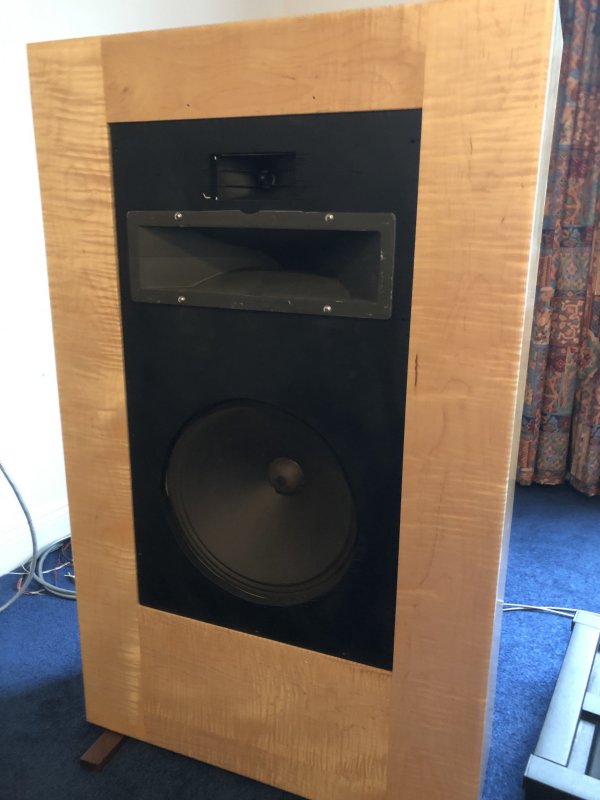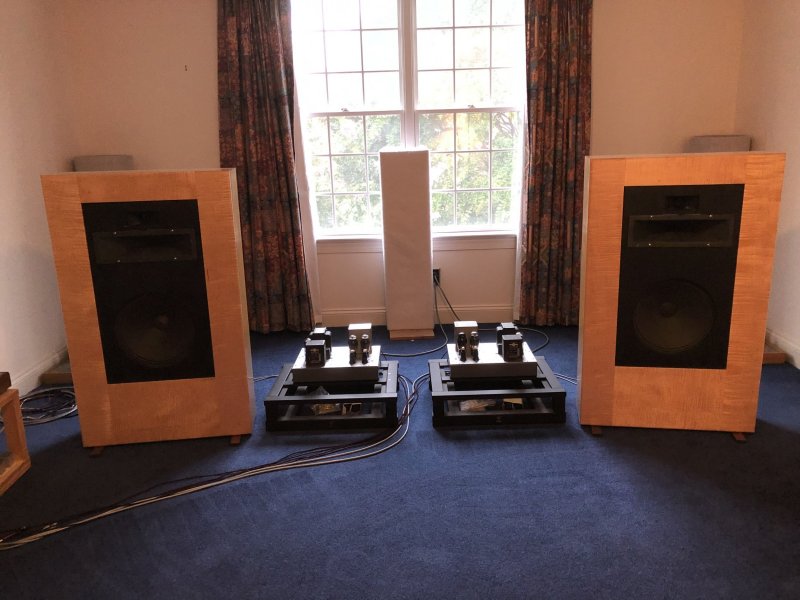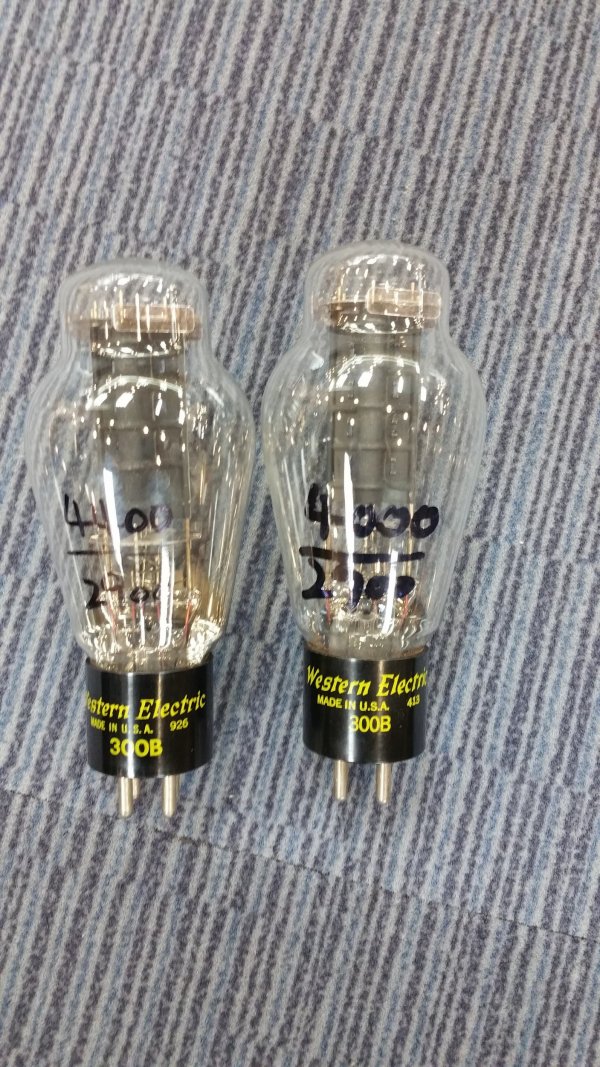I had forgotten about Dr. Podszus...you are right that one.Composite materials are not really new, neither for cabinets nor drivers...airplanes used fibreglass as early as in the 40ies, and composites sinde the 30ies. Polyphenol based foam was available, the composite membrane Dr Podszus invented was made in '35. More important, the need for composite material for a cabinet may mean it's not a great implementation, if so much vibration needs to be taken care of.
There defeinitely are new and exciting materials, yet I often doubt why they are used...it frequently appears they are selected for buzzword value.
Modern speakers vs Vintage speakers
- Thread starter thomask
- Start date
You are using an out of date browser. It may not display this or other websites correctly.
You should upgrade or use an alternative browser.
You should upgrade or use an alternative browser.
I was referring to the composite made with fiberglass and Bakelite that has been used since 1935. Bakelite is even older being developed in 1907. The first countertops sold as Corian were 1971.Bakelite was a polymer, not a composite...and as you say Corian was not available until the late 60s ...we were saying 1950. It was probably at least a decade later before it could be shaped into something other than a countertop. The first Wilsons using something like that were probably in the late 80s.
Again, there's nothing new here.
Yes....Wilson is a phenomenal marketing company. Just think about it: "X Material." Sounds super secrete, sounds like the X Files. Turns out its countertop material.Thinking of it; Paper fibre cones are made of a composite too...fiber and some form of glue
in my view it;s a great use of material properties, I hate all of that sort of marketing hypes anyway yet 'out of the box' use of materials can work very well....
I mean, cactus thorn for a phono cartridge? A filed coil MC element, all brilliant....if done right and the idea proves to work.
Using UNi-Posca opaque felt tip pens on CD's, Blu Tak to absorb vibration, applause to those coming up with the inspiration.
I mean, cactus thorn for a phono cartridge? A filed coil MC element, all brilliant....if done right and the idea proves to work.
Using UNi-Posca opaque felt tip pens on CD's, Blu Tak to absorb vibration, applause to those coming up with the inspiration.
Well Lee, why don't you post some information to back up your comment. Wilsons speakers could have been made in 1960, there is nothing in the speakers that didn't exist then.
He is an Alexia owner. He bought the first brand he got exposed to, so you are not going to get any more insight
Interesting post. Do some audiophiles spend so much time listening to something artificial that it unconsciously replaces their aural memories of live music?Ian and Al are audiophiles. The other listeners all told me the new system sound more real than the old one. I presume the meant concert halls and jazz clubs. And that was before DDK came to fine-tune it.
These people are not constantly comparing one system to another system but instead compare what they are hearing to what they remember live music sounding like. I think audio files do a little bit of both but I don’t really know.
Perhaps this winter I will get around to listening to my audio file friends’ systems again and vice a versa.
On the other hand, are non-audiophiles easily impressed?
Sometimes I see someone who reminds me of someone (e.g. celebrity or a friend) and share my thoughts to my wife. Sometimes she disagrees. I think what serves as a representation of something can vary for people, especially audio.
Here are photos of the left speaker and the pair. More photos and system details are on my Audiogon system page. Jazz Lover's Vinyl System - Virtual Systems (audiogon.com)Have you posted pictures of your system? It looks quite intriguing.


Fantastic.Here are photos of the left speaker and the pair. More photos and system details are on my Audiogon system page. Jazz Lover's Vinyl System - Virtual Systems (audiogon.com)
View attachment 81830View attachment 81831
It’s more complicated than that. Not saying you fit this description but most “hifi guys” I know really either don’t care about live music or don’t think it matters to judging hifi. I have many such debates on this forum and others that hifi should NOT be compared to live, unamplified music because it is essentially a separate art form.Interesting post. Do some audiophiles spend so much time listening to something artificial that it unconsciously replaces their aural memories of live music?
On the other hand, are non-audiophiles easily impressed?
Sometimes I see someone who reminds me of someone (e.g. celebrity or a friend) and share my thoughts to my wife. Sometimes she disagrees. I think what serves as a representation of something can vary for people, especially audio.
I suspect, but cannot prove, that this is because most have a very poor or fuzzy grasp on live sound, so it is easier to focus on hifi checklists and “detail” or “resolution” than “does this sound fit with my internal model of what live music actually sounds like?” It requires a well above average aural memory and abstraction brain power...which simply statistically most don’t possess. Perhaps in hifi, which I think is a hobby for the well off or well educated , it is higher than the general population but still a rarity IME.
I think there is a case here where people want to believe we are all equally capable...but we’re not. That is like saying if we all train hard enough we can beat Usain Bolt or beat Magnus Carlssen...
What are the amps?Here are photos of the left speaker and the pair. More photos and system details are on my Audiogon system page. Jazz Lover's Vinyl System - Virtual Systems (audiogon.com)
View attachment 81830View attachment 81831
I agree with the above, just listen to a full orchestra, or an extended, or one with a few vhoirs and try to separate all the details ans place the instruments and vocalists where they are with eyes closed ...
I tried and almost had a heart attack when a percussionist hit that wooden butchers block with a hammer large enough to come straight from an orc in the Hobbit....where he was, no clue...
*Mahler 6)
I tried and almost had a heart attack when a percussionist hit that wooden butchers block with a hammer large enough to come straight from an orc in the Hobbit....where he was, no clue...
*Mahler 6)
Last edited:
The amps in the picture are DIY Western Electric 124 which are push-pull 6L6G with roughly 8-10 watts. I have several other amps I rotate in from time to time. These include Emotive Audio Vitas (60 watts) and 46 SE (1.25 watt). The speakers are very efficient so they work well with all of them.What are the amps?
Some people prefer a PA type sound as opposed to one that can do justice to acoustic instruments. The former does very well with rock music (e.g. Pink Floyd) which I can appreciate (as do many non-audiophiles) but my personal priority is acoustic instruments and trying to come as close as I can to conveying their beauty.It’s more complicated than that. Not saying you fit this description but most “hifi guys” I know really either don’t care about live music or don’t think it matters to judging hifi. I have many such debates on this forum and others that hifi should NOT be compared to live, unamplified music because it is essentially a separate art form.
I suspect, but cannot prove, that this is because most have a very poor or fuzzy grasp on live sound, so it is easier to focus on hifi checklists and “detail” or “resolution” than “does this sound fit with my internal model of what live music actually sounds like?” It requires a well above average aural memory and abstraction brain power...which simply statistically most don’t possess. Perhaps in hifi, which I think is a hobby for the well off or well educated , it is higher than the general population but still a rarity IME.
I think there is a case here where people want to believe we are all equally capable...but we’re not. That is like saying if we all train hard enough we can beat Usain Bolt or beat Magnus Carlssen...
I’m the type who goes to the symphony and analyzes the timbre, marveling at the beauty of it all… until I get lost in the music. But even then the sonics are never far from the foreground of my mind.
So their reference is Bose?These people are not constantly comparing one system to another system but instead compare what they are hearing to what they remember live music sounding like. I think audio files do a little bit of both but I don’t really know.
Some people prefer a PA type sound as opposed to one that can do justice to acoustic instruments. The former does very well with rock music (e.g. Pink Floyd) which I can appreciate (as do many non-audiophiles) but my personal priority is acoustic instruments and trying to come as close as I can to conveying their beauty.
I’m the type who goes to the symphony and analyzes the timbre, marveling at the beauty of it all… until I get lost in the music. But even then the sonics are never far from the foreground of my mind.
Same here. I still want my system to sound good with Pink Floyd as well, but I don't think that's a contradiction. My first attention is to acoustic instruments.
Uh, every aspect of a modern Wilson speaker is innovative. You have new engineering in the phenolic material that goes into the cabinet and different materials and variations of the material have different sound qualities. You have more advanced capacitors, the new spikes are innovative, you have new types of capacitors, new geometries in the internal wiring, new geometry for time alignment, new driver technology, geometry and materials...just about everything has changed!Well Lee, why don't you post some information to back up your comment. Wilsons speakers could have been made in 1960, there is nothing in the speakers that didn't exist then.
Last edited:
This is a lie.He is an Alexia owner. He bought the first brand he got exposed to, so you are not going to get any more insight
I owned and listened to different speakers before I bought the Alexia 2s. And I have been exposed to all manner of pro monitors as well having been part of the Chesky recording team and have experience on over 200 professional recordings.
I chose Wilson because I thought they were the most faithful to my own recordings. But I also like Magico, Harbeth, some Songs Faber, Klipsch, KEF, TAD and dozens of others.
Yes....Wilson is a phenomenal marketing company. Just think about it: "X Material." Sounds super secrete, sounds like the X Files. Turns out its countertop material.
Utter bullshit. It's not countertop material.
And if you visit the factory, you see a laser test of the material that shows it has lower vibration than any other common speaker material.
Heck, they even went through many types of glue for the panel to find the best performing one.
I don't know why you have such an axe to grind against Wilson...
P.S. The material is a phenolic, it's not Corian, it's not Bakelite, and the current versions are new formulations that have been around for only the past several years. The phenolic material is so hard they use diamond drill bits on their CNC cutting machines.
Similar threads
- Replies
- 289
- Views
- 55K
- Replies
- 256
- Views
- 57K
- Replies
- 483
- Views
- 78K
- Replies
- 44
- Views
- 13K
- Replies
- 404
- Views
- 164K
| Steve Williams Site Founder | Site Owner | Administrator | Ron Resnick Site Owner | Administrator | Julian (The Fixer) Website Build | Marketing Managersing |







